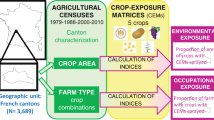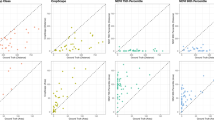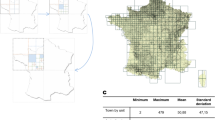Abstract
Investigation of pesticide impacts on human health depends on good measures of exposure. Historical exposure data are needed to study health outcomes, such as cancer, that involve long latency periods, and other outcomes that are a function of the timing of exposure. Environmental or biological samples collected at the time of epidemiologic study may not represent historical exposure levels. To study the relationship between residential exposure to pesticides and breast cancer on Cape Cod, Massachusetts, historical records of pesticide use were integrated into a geographic information system (GIS) to estimate exposures from large-scale pesticide applications between 1948 and 1995. Information on pesticide use for gypsy moth and other tree/vegetative pest control, cranberry bog cultivation, other agriculture, mosquito control, recreational turf management, and rights-of-way maintenance is included in the database. Residents living within or near pesticide use areas may be exposed through inhalation due to drift and volatilization and through dermal contact and ingestion at the time of application or in later years from pesticides that deposit on soil, accumulate in crops, or migrate to groundwater. Procedures were developed to use the GIS to estimate the relative intensity of past exposures at each study subject's Cape Cod addresses over the past 40 years, taking into account local meteorological data, distance and direction from a residence to a pesticide use source area, size of the source area, application by ground-based or aerial methods, and persistent or nonpersistent character of the pesticide applied. The resulting individual-level estimates of relative exposure intensity can be used in conjunction with interview data to obtain more complete exposure assessment in an epidemiologic study. While the database can improve environmental epidemiological studies involving pesticides, it simultaneously illustrates important data gaps that cannot be filled. Studies such as this one have the potential to identify preventable causes of disease and guide public policies.
This is a preview of subscription content, access via your institution
Access options
Subscribe to this journal
Receive 6 print issues and online access
$259.00 per year
only $43.17 per issue
Buy this article
- Purchase on Springer Link
- Instant access to full article PDF
Prices may be subject to local taxes which are calculated during checkout


Similar content being viewed by others
Abbreviations
- GIS:
-
geographic information systems
- CCMCP:
-
Cape Cod Mosquito Control Project
- MA-DEM:
-
Massachusetts Department of Environmental Management
- USGS:
-
United States Geological Survey
- ISCST3:
-
Industrial Source Complex Short-Term air model
- APHIS:
-
US Department of Agriculture Animal and Plant Health Inspection Service
- USDA:
-
US Department of Agriculture
- US EPA:
-
US Environmental Protection Agency
- MA DFA:
-
Massachusetts Department of Food and Agriculture
- MA DNR:
-
Massachusetts Department of Natural Resources
- ORETF:
-
Outdoor Residential Exposure Task Force
- NCFAP:
-
National Center for Food and Agricultural Policy
References
Aschengrau A Ozonoff MD Coogan P Vezina R Heeren T Zhang Y, 1996. Cancer risk and residential proximity to cranberry cultivation in Massachusetts, Am J Public Health. 86(9): 1289–1296
Bell E Hertz-Picciotto I Beaumont JJ, 2001. A case–control study of pesticides and fetal death due to congenital anomalies, Epidemiology. 12(2): 148–156
Betts K, 1997. Mapping the environment, Environ Health Perspect. 105(6): 594–596
Bird SL, 1995. A compilation of aerial spray drift field study data for low-flight agricultural application of pesticides In: Leng M.L., Leovey E.M.K., and Zubkoff P.L. (Eds.). Agrochemical Environmental Fate: State of the Art CRC Lewis Publishers
Bird SL, 1997 Personal Communication US EPA National Exposure Research Laboratory
Bird SL Esterly DM Perry SG, 1996. Off-target deposition of pesticides from agricultural aerial spray application, J Environ Qual. 25(5): 1095–1104
Brody JG Rudel RA Melly SJ Maxwell NI, 1998. Endocrine disruptors and breast cancer, Forum Appl Res Public Policy. 13(3): 24–31
Burnham CM June 1994. A summary of Massachusetts forest pest conditions 1905–1993 Unpublished manuscript, in progress
California Environmental Protection Agency 1995 Pesticide Use Reporting: An Overview of California's Unique Full Reporting Systems. Information Systems Branch, Department of Pesticide Regulation, California Environmental Protection Agency, CA
Cape Cod Commission, W.R.O 1990 In: Eichner E.M., and Cambareri T.C. (Eds.). The Cape Cod Golf Course Monitoring Project Cape Cod Commission, Barnstable, MA
Clark JM Marion JR Tessier DM, 1993. Effect of spray adjuvant on off-site airborne and deposited parathion from cranberry bogs treated by aerial application and chemical irrigation, Pesticides in Urban Environments — Fate and Significance. 203rd National Meeting of the American Chemical Society, San Francisco, CA
Cranberry Institute 2000 Massachusetts Cranberry Crop Profile. Cranberry Institute, Wareham, MA
Davis DL Bradlow HL Wolff M Woodruff T Howl DG Anton-Culver H, 1993. Medical hypothesis: xenoestrogens as preventable causes of breast cancer, Environ Health Perspect. 101(5): 372–377
Davis BNK Brown MJ Frost AJ Yates TJ Plant RA, 1994. The effects of hedges on spray deposition and on the biological impact of pesticide spray drift, Ecotoxicol Environ Saf. 27: 281–293
Drivas PJ, 2000 Air Modeling of Pesticide Drift. Silent Spring Institute, Newton, MA
Drivas PJ, 2001 Addendum to Air Modeling of Pesticide Drift. Silent Spring Institute, Newton, MA
Huang Y-L Batterman S, 2000. Residence location as a measure of environmental exposure: a review of air pollution epidemiology studies, J Expos Anal Environ Epidemiol. 10(1): 66–85
Jordan Co. 1986 E.C. Phase II, Stage 2 Study. Installation Restoration Program, Massachusetts Military Reservation. E.C. Jordan Co
Kumar A Bellam N Sud A, 1999. Performance of an industrial source complex model: predicting long-term concentrations in an urban area, Environ Prog. 18(2): 93–100
Lichtenstein P Holm N Verkasalo P Iliadou A Kaprio J Koskenvuo M Pukkala E Sskytthe A Hemminki K, 2000. Environmental and heritable factors in the causation of cancer: analyses of cohorts of twins from Sweden, Denmark, and Finland, N Engl J Med. 343(2): 78–85
Longley M Cilgi T Jepson PC Southerton NW, 1997. Measurements of pesticide spray drift deposition into field boundaries and hedgerows: 1. Summer applications, Environ Toxicol Chem. 16(2): 165–172
MacConnell WP, 1975. Remote Sensing 20 Years of Change in Massachusetts 1952–1972: Classification Manual, Land Use and Vegetative Cover Mapping Massachusetts Agricultural Experiment Station, University of Massachusetts at Amherst, Amherst, MA
MacConnell W Swartout D Stone J, 1984 Land Use Update for Cape Cod and the Islands with Area Statistics for 1951, 1971, and 1980. Massachusetts Agricultural Experiment Station, College of Food and Natural Resources, University of Massachusetts at Amherst, Amherst, MA
Madigan MP Ziegler RG Benichou J Byrne C Hoover RN, 1995. Proportion of breast cancer cases in the United States explained by well-established risk factors, J Natl Cancer Inst. 87(22): 1681–1685
Massachusetts Department of Agriculture 1948 The Cranberry Industry in Massachusetts. Massachusetts Department of Agriculture, Massachusetts
Massachusetts Department of Agriculture 1957 The Cranberry Industry in Massachusetts. Massachusetts Department of Agriculture, Massachusetts
Massachusetts Department of Agriculture 1968 The Cranberry Industry in Massachusetts. Massachusetts Department of Agriculture, Massachusetts
Massachusetts Department of Environmental Conservation 1949 A Report to Commissioner Arthur T. Lyman, Massachusetts Department of Conservation, on the 1949 Barnstable County Spray Program. Massachusetts Department of Environmental Conservation, Massawchusetts
Massachusetts Department of Environmental Management 1991 Maps: Gypsy Moth Defoliation. Individual Years, 1970–1991. Massachusetts Department of Environmental Management, Massachusetts
Massachusetts Department of Natural Resources 1974 Gypsy Moth: A Policy Related to People Rather Than the Deep Forests. Massachusetts Department of Natural Resources, Massachusetts
McLane W, 1997 Personal Communication. US Department of Agriculture Animal and Plant Health Inspection Services
O'Leary ES Vena J Freudenheim JL Calkins H Brasure J, 2000. Historical environmental exposure to pesticides in a nested case–control study of breast cancer, Epidemiology. 11 Suppl. 4 S88
Pew Environmental Health Commission 2000 America's Environmental Health Gap: Why the Country Needs a Nationwide Health Tracking Network (Technical Report). Environmental Health Tracking Project Team, Department of Health Policy and Management, Johns Hopkins School of Hygiene and Public Health, Baltimore, MD
Rathburn CB Dukes JC, 1989. A comparison of the mortality of caged adult mosquitoes to the size, number and volume of ULF spray droplets sampled in an open and a vegetated area, J Am Mosq Control Assoc. 5(2): 173–175
Rudel RA Geno P Melly SJ Sun G Brody JG, 1998. Identification of alkylphenols and other estrogenic phenolic compounds in wastewater, septage, and groundwater on Cape Cod, Massachusetts, Environ Sci Technol. 32(7): 861–869
Rudel RA Geno PW Sun G Yau A Spengler JD Vallarino J Brody JG, 2001. Methods to detect selected potential mammary carcinogens and endocrine disruptors in commercial and residential air and dust samples, J Air Waste Manage Assoc. 51: 499–513
Silent Spring Institute 1997 Cape Cod Breast Cancer and Environment Study Final Report. Silent Spring Institute, Newton, MA
Silent Spring Institute 2000 Cape Cod Breast Cancer and Environment Atlas. Newton, MA Also available online at www.silentspring.org
Silent Spring Institute 2000 Exposure Assessment in the Cape Cod Breast Cancer and Environment Study. Newton, MA
Simcox N Fenske RA Wolz SA Lee IC Kalman DA, 1995. Pesticides in household dust and soil: exposure pathways for children of agricultural families, Environ Health Perspect. 103(12): 1126–1134
Snedeker SM, 2001. Pesticides and breast cancer risk: a review of DDT, DDE, and dieldrin, Environ Health Perspect. 109(Suppl. 1): 35–47
Soto AM Sonnenschein C Chung KL Fernandez MF Olea N Serrano FO, 1995. The E-SCREEN assay as a tool to identify estrogens: an update on estrogenic environmental pollutants, Environ Health Perspect. 103(Suppl. 7): 113–122
Sturgeon SR Schairer C Gail M McAdams M Brinton LA Hoover RN, 1995. Geographic variation in mortality from breast cancer among white women in the United States, J Natl Cancer Inst. 87(24): 1846–1853
Terris B, 1990 Report for Directed Study EB 901: Pesticide Application to Cranberry Bogs in Barnstable County. Boston University School of Public Health, Boston
Teske M Bird S Esterly D Ray S Perry S, 1997. A user's guide for AgDRIFT 1.0: a tiered approach for the assessment of spray drift of pesticides CDI Technical Note No. 95-10, Prepared for D.R. Johnson, Project Manager, Spray Drift Task Force
US Department of Agriculture 1974 Proposal for eradication of the brown-tail moth. Memorandum from V.A. Lafleur, State Inspector, to J.T. Koski, Regional Director, Animal and Plant Health Inspection Service
US Environmental Protection Agency 1995 User's Guide for the Industrial Source Complex (ISC3) Dispersion Models: Vol. 1. User Instructions. Office of Air Quality Planning and Standards, Research Triangle Park, NC
Vine M Degnan D Hanchette C, 1997. Geographic information systems: their use in environmental epidemiologic research, Environ Health Perspect. 105(6): 598–605
Wakefield J, 2000. Human exposure: the key to better risk assessment, Environ Health Perspect. 108(12): A559–A565
Ward MH Nuckols JR Weigel SJ Maxwell SK Cantor KP Miller RS, 2000. Identifying populations potentially exposed to agricultural pesticides using remote sensing and a geographic information system, Environ Health Perspect. 108(1): 5–12
Xiang H Nuckols JR Stallones L, 2000. A geographic information assessment of birth weight and crop production patterns around mother's residence, Environ Res. section A(82): 160–167
Acknowledgements
This research was funded by an appropriation of the Massachusetts legislature administered by the Massachusetts Department of Public Health. Additional support for preparation of this manuscript was provided by a grant from the Boston Affiliate of the Susan G. Komen Breast Cancer Foundation. We thank Joan Gardner and staff of Applied Geographics for technical assistance in development of the Cape Cod Study GIS. We gratefully acknowledge the help and dedication of many Cape Cod residents, including Ruth Jacobs and the members of the Public Advisory Committee. We thank many other individuals who provided information during interviews, with special thanks to Charlie Burnham, MA-DEM Bureau of Shade Tree Management; Dick Kelliher, retired MA-DEM Supervisor for Cape Cod; and Win H. McLane, Section Leader, Insecticide and Application Technology Section, USDA. We also acknowledge the contributions of Cheryl Osimo (Cape Cod outreach coordinator for the study), research assistants Jennifer Roberts Kachajian and Christina Spaulding, Michael McClean for assistance with golf course superintendent interviews, and Christopher Swartz for assistance in revisions. We thank Jay Nuckols for contributions to meetings of the study Science Advisory Committee. We also thank Betsey Noth for her thoughtful review and Maura Nelson and Caitlin Willoughby for editorial assistance.
Author information
Authors and Affiliations
Corresponding author
Rights and permissions
About this article
Cite this article
BRODY, J., VORHEES, D., MELLY, S. et al. Using GIS and historical records to reconstruct residential exposure to large-scale pesticide application. J Expo Sci Environ Epidemiol 12, 64–80 (2002). https://doi.org/10.1038/sj.jea.7500205
Received:
Published:
Issue Date:
DOI: https://doi.org/10.1038/sj.jea.7500205
Keywords
This article is cited by
-
Pesticide toxicity assessment and geographic information system (GIS) application in small-scale rice farming operations, Thailand
Scientific Reports (2022)
-
Evaluating the accuracy of satellite-based methods to estimate residential proximity to agricultural crops
Journal of Exposure Science & Environmental Epidemiology (2022)
-
Passive environmental residential exposure to agricultural pesticides and hematological malignancies in the general population: a systematic review
Environmental Science and Pollution Research (2021)
-
Occupational exposure to pesticides: development of a job-exposure matrix for use in population-based studies (PESTIPOP)
Journal of Exposure Science & Environmental Epidemiology (2018)
-
Assessment of residential environmental exposure to pesticides from agricultural fields in the Netherlands
Journal of Exposure Science & Environmental Epidemiology (2018)



